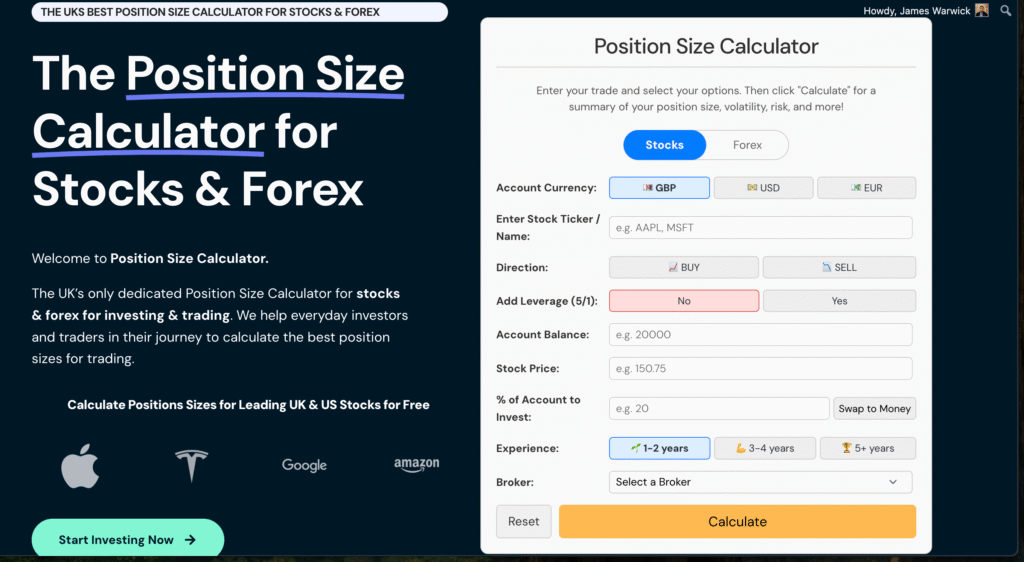What is a Position Size Calculator? A Practical Guide for UK Traders.

There’s a phrase I often repeat to newer traders: “It’s not the trade that gets you, it’s the size.” It’s one of those lessons that you don’t fully understand until you’ve been on the wrong side of a move… staring at a loss that’s far too big for your account. I learned that one the hard way, back in 2014, trading GBP/JPY with a position that was more bravado than sense. It only took one economic release to teach me the value of risk management. And that’s exactly where position size calculators come in.
A position size calculator is a tool – often free, often overlooked, that helps traders determine how much to trade based on the size of their account and the amount of risk they’re willing to take. It doesn’t promise profits, but it does help you avoid catastrophic losses. And that, in my experience, is more important in the long run.
Why Position Sizing Matters
Let’s be blunt: trading is more about risk management than it is about being right. You could have a system that wins only 40% of the time and still make money if your losers are smaller than your winners. But if you’re risking 10% of your account per trade, even a good streak can come undone in a few bad trades.
That’s why calculating your position size properly matters. It enforces discipline. It ensures consistency. And it removes the guesswork when markets get emotional.
What Does a Position Size Calculator Do?

At its core, a position size calculator takes a few key inputs:
- Account Size: How much you have in your trading account.
- Risk per Trade: Usually expressed as a percentage. Most traders risk between 0.5% and 2% per trade.
- Stop Loss: How many pips (or points) you’re willing to lose if the trade doesn’t go your way.
- Instrument Volatility / Pip Value: This varies by market, especially between forex, stocks, and indices.
With those inputs, the calculator tells you how large a position you can take while staying within your risk tolerance. For example, if you have a £10,000 account and you’re risking 1% (£100) with a 50 pip stop loss, the calculator might suggest a trade size of 0.2 lots (depending on the instrument).
How to Calculate Stock Position Sizes
Trading stocks in the UK, especially through spread betting or CFDs, requires a slightly different approach to forex. You’ll still need to know your account size and risk tolerance, but you also need to know the price per point and the distance to your stop loss.
Let’s say you’re trading Tesco shares at 250p and you plan to set your stop loss 10p below your entry price (at 240p). You’re risking 10 points per share.
If you have a £5,000 account and want to risk 1%, that gives you £50 risk per trade. Divide £50 by 10 points, and you get a position size of £5 per point. That’s how much you should stake per point on your spread bet to stay within your risk tolerance.
It’s not rocket science, but it does require discipline.
Calculating Forex Position Sizes

Forex brings a bit more complexity due to the pip value varying by currency pair and trade size. But the principle is exactly the same.
Let’s say you have a £10,000 account and want to risk 2% per trade, that’s £200. You’re looking to trade EUR/USD with a 50 pip stop loss.
Now, in a standard lot (100,000 units), each pip in EUR/USD is worth about $10. In micro lots (1,000 units), it’s worth about $0.10. Your job is to find the trade size where 50 pips equals £200 of risk. You can either do the math yourself or use a calculator.
In this case, a trade of around 0.4 standard lots would give you £200 risk over 50 pips.
The key is to make this calculation before you trade—not after the market moves against you.
Is It the Same as a Lot Size Calculator?
You might see the term “lot size calculator” thrown around, especially on forex trading forums. And yes, they’re closely related. But they’re not quite the same thing.
A lot size calculator usually focuses just on converting risk into lots—mainly for forex. A position size calculator, by contrast, covers the broader picture: risk per trade, pip or point distance, and trade size across different asset classes (forex, stocks, indices, commodities).
Think of it this way: all lot size calculators are position size calculators, but not all position size calculators are limited to lot sizes.
The Problem with Ignoring It
I once spoke to a friend of mine who was swing trading gold CFDs. He was up 40% over a few weeks and feeling confident… too confident, as it turned out. He took a double-sized trade, gold dipped $10, and he lost nearly all his gains. His mistake? He let his emotions dictate his size. No calculator involved.
There’s a certain calmness that comes from knowing your position is sized appropriately. You’re not watching every tick. You’re not sweating over small retracements. You’ve done the work upfront, so you can let the trade play out.
Where to Find One
Most good brokers offer one built into their platforms. If not, there are plenty of free position size calculators online. Just make sure they allow you to set account size, risk %, stop loss, and instrument.
If you’re trading from the UK, especially using spread betting platforms like IG, CMC Markets, or SpreadEx, you’ll find calculators tailored for points rather than pips. That distinction matters. Some calculators are US-focused, built for pip-based forex trading, and won’t match UK product structures.
When to Use It
Use it before every trade. Not once a week. Not when you remember. Before each and every trade, especially if you’re changing instruments or volatility has shifted.
I keep mine as a browser bookmark, right next to my charting platform. It’s become a non-negotiable part of my routine… like checking the weather before a walk in Scotland.
Advanced Tips: Adapting for Volatility and Position Scaling
- Volatility-based stops: Instead of fixed pip/point stops, you might use ATR (Average True Range) to set stops based on recent volatility. Your calculator then needs to reflect that—because a 50 pip stop on GBP/JPY isn’t the same beast as 50 pips on EUR/USD.
- Scaling in/out: Some traders like to enter in stages. If you do this, calculate your total size and then break it into parts. Don’t abandon the logic just because you’re spreading out your entries.
- Trailing stops and dynamic sizing: More advanced, but some traders adjust their position size based on how far price has moved in their favour. This is more common in trend following systems and requires a dynamic spreadsheet or tool.
What It’s Not
A position size calculator isn’t a holy grail. It won’t make you a better trader overnight. It doesn’t predict direction. It doesn’t fix a bad strategy. But it will keep you in the game long enough to improve.
In fact, if I had to pick one tool to take with me to a desert island trading desk (along with a good broker and strong coffee), it’d be this one. Because as long as you can manage risk, you can survive drawdowns and build consistency.
Final Thoughts

I’ve traded through Brexit, COVID, and more flash crashes than I care to admit. And if there’s one consistent thread that runs through the traders who are still standing, it’s this: they size their trades properly.
There’s no glamour in it. You won’t hear about it in the pub or see it in TikTok trading montages. But real traders, professional, consistent, risk-aware, use tools like position size calculators every single day.
If you’re not using one yet, start today. You’ll wonder how you ever traded without it.
And if you’re already using one, take this as your nudge to use it with every trade, not just the ones you’re nervous about. Because the best trades don’t just have good entries, they’re sized right, too.
James is a full-time UK-based trader for prop firms and using private capital since June 2010. Based in the Edinburgh, Scotland he has been active in the UK finance space for the last 10 years and helps other UK traders and investors calculate lot sizing, position sizing and investing with helpful tools.